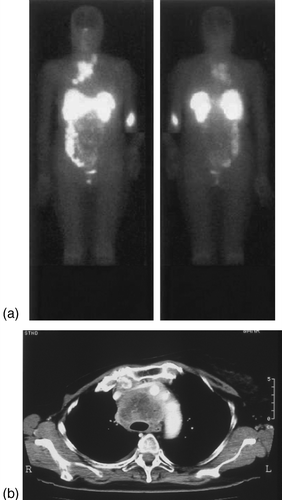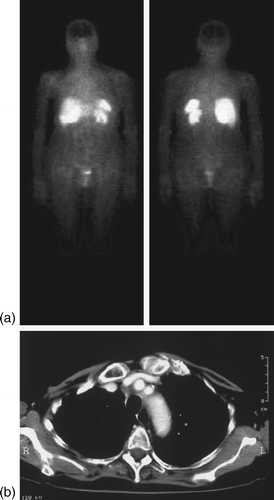To the Editor
A 62-year-old womanpresented in April 2002, complaining of dry cough, dysphonia and dyspnoea. A primary unknown fast-growing neuroendocrine carcinoma was diagnosed. The disease involved mediastinum and neck nodes. A complete response with chemotherapy and a consolidation with 90Y-Dotatoc were obtained.
Hyperlipaemia, smoking and hypertension were present in the remote history. In 1976 the patient underwent a right mastectomy and complementary radiotherapy of 36.6 Gy on the chest wall. The diagnosis was: ductal invasive carcinoma T2N1M0, unknown hormonal receptors. No pharmacological therapy followed. In December 1983 a subcutaneous locoregional relapse was treated with radiotherapy, 40.25 Gy. Chemotherapy with Cooper CMF-V regimen followed until August 1984. During chemotherapy a polyclonal hypergammaglobulin was detected. Bone marrow aspirate showed no sign of hematologic neoplasia.
In August 2000 postero-lateral miocardial infarction occurred. First thrombolysis and then Percutaneous Transluminal Coronary Angioplasty (PTCA) were performed successfully.
In July 2002, after two months with dry cough, dysphonia appeared and laryngoscopy was performed, that showed right vocal cord paralysis. The subsequent CT-scan showed an antero-superior mediastinal mass, of 8.5 cm cranio-caudal×7.5 cm transversal diameters, without clivage plan to great vessels ( lower). Right internal mammary, bilateral latero-cervical, and right supraclavicular adenopathies were evident. Right supraclavicular lymphadenectomy was performed. Histologic examination revealed “metastasis from neuroendocrine carcinoma, Chromogranin-A and Synaptophysin positive, Ki67 = 90%”. [111Indium-Diethylenetriaminopenta-acetic (111In-DTPA)] octreotide total-body scintigraphy (Octreoscan®) showed a very high uptake on the mass and adenopathies ( a).
Figure 1. Images before treatment. 111In octreotide scans (upper) show uptake in the mediastinum. CT-scan images (lower) show a mass in the mediastinum.

The patient complained of quickly worsening dysphonia, dyspnoea and thoracic constraint sensation. She was at high risk of forthcoming asphyxia.
Since mediastinal radiotherapy could not be performed because of previous irradiation, chemotherapy with Carboplatin AUC = 5 and Etoposide 100 mg/sm/day over three days, every three weeks, was started. From August 2002 to December 2002 seven courses were administered. Improvement of symptoms occurred just after the first course. Plasmatic Chromogranin-A and Neuron-Specific Enolase decreased to almost normal values, from baseline five and three times upper normal limit respectively. CT-scan showed >50% reduction of the mass and cervical adenopathies after the first three courses and a complete regression after six courses ( lower). Two further courses of chemotherapy were planned, but the eighth one was not performed because of bone marrow toxicity.
Figure 2. Images after treatment. 111In-octreotide scans (upper) and CT-scan images (lower) show a complete response.

Octreoscan® plus Single Photon Emission Computed Tomography (SPECT) showed an almost total disappearance of uptake, just after the conclusion of chemotherapy.
Based on the high initial and slight residual uptake at octreoscan®, three administrations of 90Y-[tetraazacyclo-dodecanetetra-acetic acid (DOTA)-D-Phe1-Tyr3-Octreotide] (90Y-DOTATOC) therapy were performed, with a total dose of 170 mCi, from February 2003 to September 2003. In December 2003 the octreoscan® showed a complete response ( a).
The patient is currently alive and disease-free, and she has not been received any specific therapy since the last 90Y-Dotatoc in September 2003.
We could not identify the primary tumour in our patient. Based on the instrumental picture, primary mediastinal neuroendocrine carcinoma should be considered. The neuroendocrine carcinomas are usually located in parenchymatous organs Citation[3]. Rare cases of neuroendocrine carcinomas located in the mesentery, retroperitoneum, inferior vena cava, presacral region and posterior mediastinum have been reported Citation[1], Citation[2]. Most of the non-pulmonary neuroendocrine carcinomas arising in the mediastinum are of thymic origin. However, several malignancies could present as a neoplastic mass localized to the upper-mid mediastinum. In the differential diagnosis, sarcoma, neuroblastoma, lymphoma, small cell carcinoma, and neuroendocrine carcinoma should be considered Citation[4].
We could not verify if the thymus was involved because the mediastinal mass was not operated or biopsied. In any case, the treatment of a rapidly progressive neuroendocrine carcinoma, irrespective from the site, is based on chemotherapy. Cisplatin and etoposide is the frequently used combination, based on the analogy of small cell lung cancer (SCLC). We chose carboplatin instead of cisplatin in order to avoid emetic, nephro-, and neuro-toxicity as they are equally effective in SCLC.
90Y-DOTATOC represents a combination of octreotide and a therapeutic β-emitting radioisotope. The affinity of DOTATOC for somatostatin receptors subtypes 2 and 5, tested in vitro, was found to be very high. Our institute is one of the few centers worldwide to have experience with DOTATOC, obtaining more than 20% of partial/complete responses in patients with neuroendocrine carcinomas from several origins, with an acceptable toxicity Citation[5].
Somatostatin (SST)-analog therapy, both parenteral or radiotargeted, represents an alternative to chemotherapy, in order to avoid useless toxicity, in the treatment of slow-growing neuroendocrine carcinomas. Nevertheless, high octreoscan® uptake can be seen also in fast-growing diseases, when chemotherapy usually represents the first choice. In these cases, radiolabelled octreotide could be considered as a means of consolidation after the first response to chemotherapy. In particular, in our patient, SST-analog therapy represented a useful choice when an almost complete response was obtained, but toxicity obstructed the chemotherapy and some residual octreoscan® uptake remained. The sequential combination is probably the correct method because myelotoxicity, typical of both treatments, would not allow the concurrent use.
Therefore, the sequential combination of carboplatin/etoposide and 90Y-DOTATOC could represent a good therapeutic option in patients with highly aggressive SSTRs-positive neuroendocrine carcinoma.
References
- Modlin IM, Lye KD, Kidd M. A 5-decade analysis of 13,715 carcinoid tumors. Cancer 2003; 97: 934–59
- Kacar F, Meteoglu I, Sen S, Levi E. Primary neuroendocrine carcinoma of the mediastinum. Pathol Oncol Res 2002; 8: 200–1
- Horie Y, Kato M. Neuroendocrine carcinoma of the posterior mediastinum: A possible primary lesion. Arch Pathol Lab Med 1999; 123: 933–6
- Wick MR, Rosai J. Neuroendocrine neoplasm of the mediastinum. Semin Diagn Pathol 1991; 8: 35–51
- Chinol M, Bodei L, Cremonesi M, et al. Receptor-mediated radiotherapy with Y-DOTA-DPhe-Tyr-octreotide: The experience of the European Institute of Oncology Group. Semin Nucl Med 2002; 32: 141–7